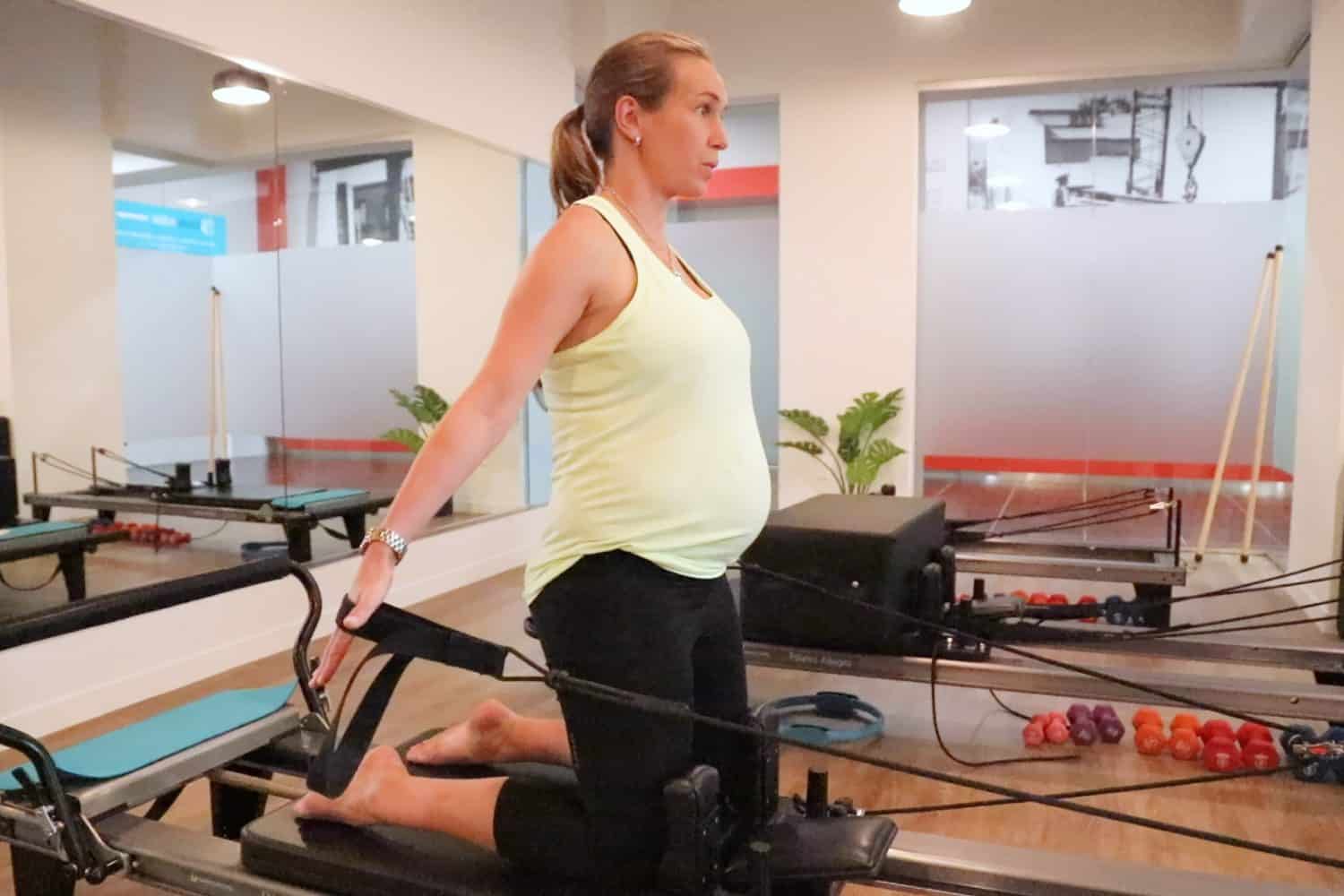Congratulations, you’re pregnant!
Pregnancy and exercise. These two words can lead to an endless debate depending on who you’re listening to but the bottom line is exercising appropriately during pregnancy is safe…and essential. We’re speaking both professionally and from experience.
Of course there is no OSFA approach to exercise, as each women’s pregnancy is going to be as different as chalk and cheese. We will consider your medical history, pre-conception exercise habits, previous birth history, how you conceived, general health and lifestyle and stage of pre/postnatal term when you present to Studio Rubix.
Below we outline our best practice advice and approach to pregnancy and postnatal exercise, using our formal specialist training and the expertise of a Pelvic Health Physiotherapist.
Our first aim is to put your mind at ease, and clear up the conflicting advice that is out there. We will keep you safe. We strongly recommend if you are pregnant, whether or not you are presenting with any complications, to book a session with one of our team to discuss options.
Things for you to do:
- Tell us when you find out you’re pregnant (especially before that 12-week mark)
- Remind us when you edge towards each trimester so we can modify appropriately
- Inform us of any niggles, injuries, apprehension. Your intuition is important and valid.
Welcome to the first trimester
Firstly congratulations on growing a wee human!
We want to support you in creating exercise routines that support energy, immunity and fitness gains.
During the first trimester, you may experience days where you feel absolutely fine and nothing changes in terms of exercise.
Other days you feel like you’ve been hit with a horrendous hangover, or experience nausea, faintness, light-headedness which is generally due to your body adapting to the hormonal shifts in the early stages. Care should be taken changing positions from lying to standing, getting heart rate up and basically not overdoing it. We’ll suggest easier springs or weights, avoiding movements that elevate the heart rate like static holds and raising arms above head.
Listen to your body cues and consider your energy levels when deciding what type of exercise to do; some days you’re up for anything, other days a more low key approach is needed. Our trainers know how to adapt sessions to suit your energy levels and we’ll keep an eye on you, getting hands on to correct technique and adjust accordingly.
And…we’ll introduce you to your pelvic floor. You’ll become great friends.
Enter Second Trimester
So hopefully, cross fingers, you are starting to feel slightly less hungover and jaded, no longer clutching the toilet bowl or feeling hit by a bus. Great time to focus on getting strong for what’s to come. We will modify exercises that increase intra-abdominal pressure depending on your physical makeup, injury history and ability. We’ll provide modifications to things like crunching and full planking. But we’re not wrapping you in cotton wool; we’ll make sure you are exercising effectively for results. Just because we’re avoiding certain abdominal exercises, we’re not avoiding them all.
Pelvic floor lowdown
Your pelvic floor muscles which you, all going to plan, have control over, will become a focus of your program. For some women they experience weakness or inability to activate effectively, whilst others experience a tight pelvic floor. If you’re unsure, we highly recommend seeing a Pelvic Health Physiotherapist to assess and advise on treatment. We’ll teach you how to continue strengthening or relaxing these, along with integrating abdominal and pelvic muscles to create a strong core. This will be the foundation for a strong body reducing the risk of injury. A 12-week program is enough to make changes.
How hard to puff?
You’ll always be encouraged to breathe. The diaphragm and pelvic floor are interlinked. Yes, some people tend to hold their breath, which is not ideal as it raises heart rate and affects ability to correctly activate pelvic floor. In terms of getting your heart rate up whilst exercising, how much will depend on what feels right for you with no adverse side effects. There is no OSFA approach so we will tailor advice to you individually.
Feeling a little lax?
Pelvic ligaments become a little more pliable as Relaxin hormone is released and kicks in to do it’s thing and aid birth by allowing the pelvis to stretch. So you may feel extra mobility or lax in positions and whilst the idea of the splits may be fun, this is not the time. We’ll adjust springs, resistance, depth and stability to suit you and keep you safe, preventing strain or injury to the pelvis. Many women experience pelvic pain and it is important you recognise the signs and adjust immediately. Certain stretches will be modified and we’ll show you these.
On the home straight, third trimester.
So your body may have morphed into various shapes and sizes. You may or may not be able to glimpse your ankles! This is the time when balance starts to be challenged, your centre of gravity is fast shifting so extra care with balance is necessary. The weight of your belly makes typical exercises extra challenging so you may not have as much staying power, and we’ll work with that. You may prefer side-lying exercises.
If you’re lucky you’ll fly through the 3rd trimester without too many niggles. For others, and from experience, you may experience pelvic pain, difficulty walking or doing regular exercises. Again we’re trained to support you and adjust to minimise the aggravation. This may be via modifying springs, taking extra rests, using props like pillows or foam pads.
You are still safe to exercise.
You may feel comfortable to attend reformer pilates classes and personal training appointments right up to bubs arriving or stop a few weeks out. It’s up to you. From experience, keeping exercise as part of the physical routine helps to keep the mind strong too.
Post-baby body.
It exists, but it is different to a pre-baby body because you’ve gone through massive physical changes!
Let’s aim for strong, functional, pain-free and confident. Depending on your birthing experience we’d like you to think about pelvic floor activation exercises on day 2 or 3 post-birth (we know, tedious, and likely last thing you want to do, but it is important to get that brain-muscle connection back). Pelvic floor exercises should be done when comfortable; they shouldn’t be painful.
Gradually return to walking, initially 5mins most days for first week, adding 5mins each week. But this is a guide. You may be able to do less or more. We can help, so get in touch post-birth and bring your baby. You can introduce body weight, low impact strength exercises like sit to stand squats, hip raises within 4 weeks. At the end of the day you are likely bending, lifting, squatting every day anyway so let’s get strong in those everyday movements.
At around 6-8 weeks feel welcome to come back to reformer classes and we’ll keep some exercises modified for a while. We’ll avoid exercises like crunches and full planks for a while yet until your organs have nestled back into place, and give time for ligaments to return to normal length. Continue to train (strengthening and/or relaxing) the pelvic floor, think of them like the sling providing support for the pelvic organs, maintaining continence, reducing back or pelvic pain, and preventing prolapse. We want you to bounce on that tramp with your baby one day, so invest in the work.
Be gentle with yourself, remember your pelvic floor muscles have stretched to around 2.5x their resting length, so this area needs time to heal…not to mention you may have sustained muscle or skin tears. This is not the time for a high-intensity burpee session.
Relaxin hormone is circulation until around 12 weeks post-birth, however, if you continue to breastfeed you will be at increased risk of musculoskeletal injury whilst breastfeeding, so the recommendation is to wait until after 12 weeks of birth to gradually and progressively return to high-intensity exercise like running. So eager beavers, just settle down and talk to us if this freaks you out so we can put some strategies in place.
Enjoy the pathway of getting strong and stronger again, with a little baby in tow. It will be challenging and we’re here to support you.
Please note:
- We strongly advise you tell one of our trainers when you find out you are pregnant and arrange for a time to discuss the above
- Remind us when you approach each new trimester so we can enforce the changes needed and again discuss these with you.
- Inform us of any health issues or injuries you may have or any apprehension with regards to your exercise in our studio.
- The above Post Natal information is based on anatural, non-complicated birth. If you had a cesarean birth, postnatal surgery or other intervention, your exercise return will be guided by your specialist.
The above guidelines have been composed by the directors of Studio Rubix and reviewed by Nichole Cobham, Pelvic Health Physiotherapist.



